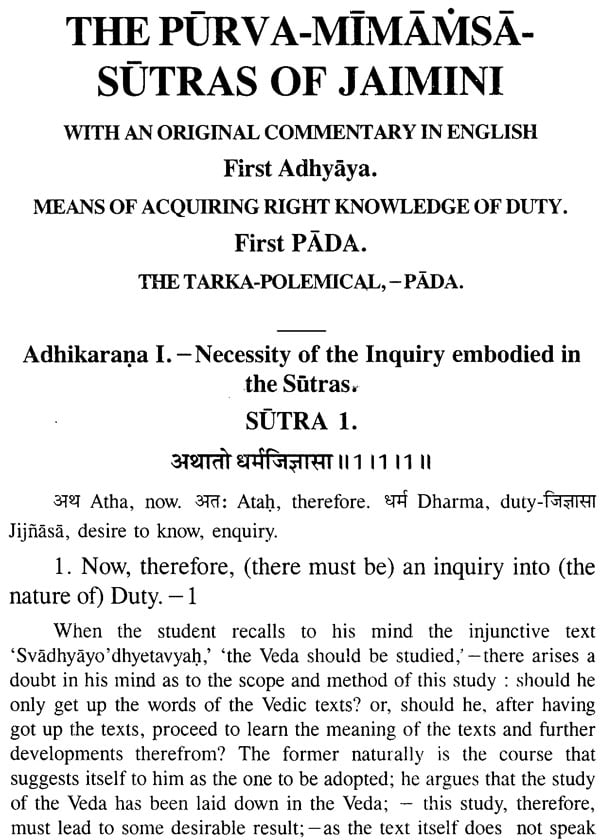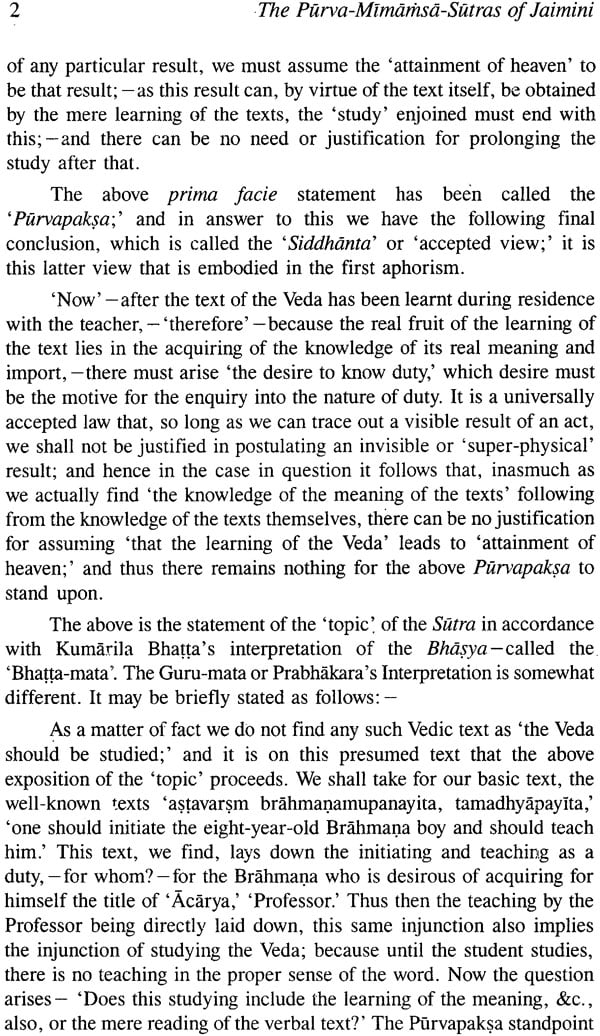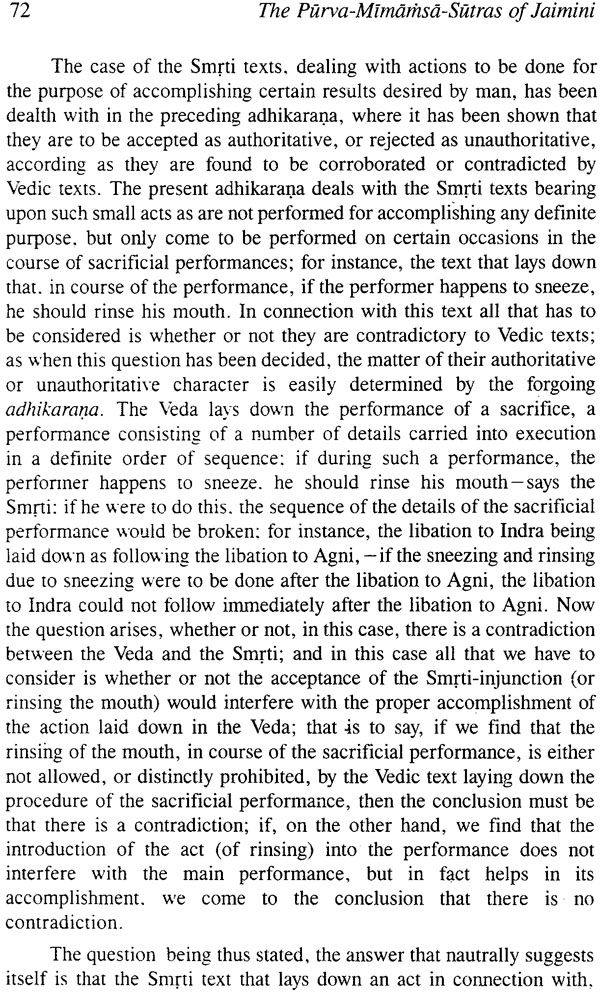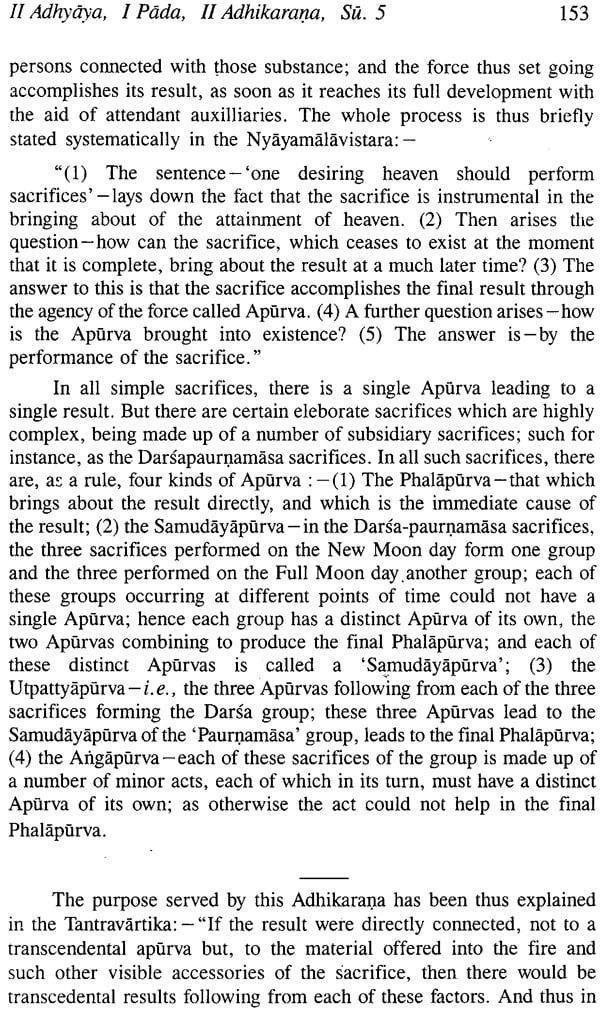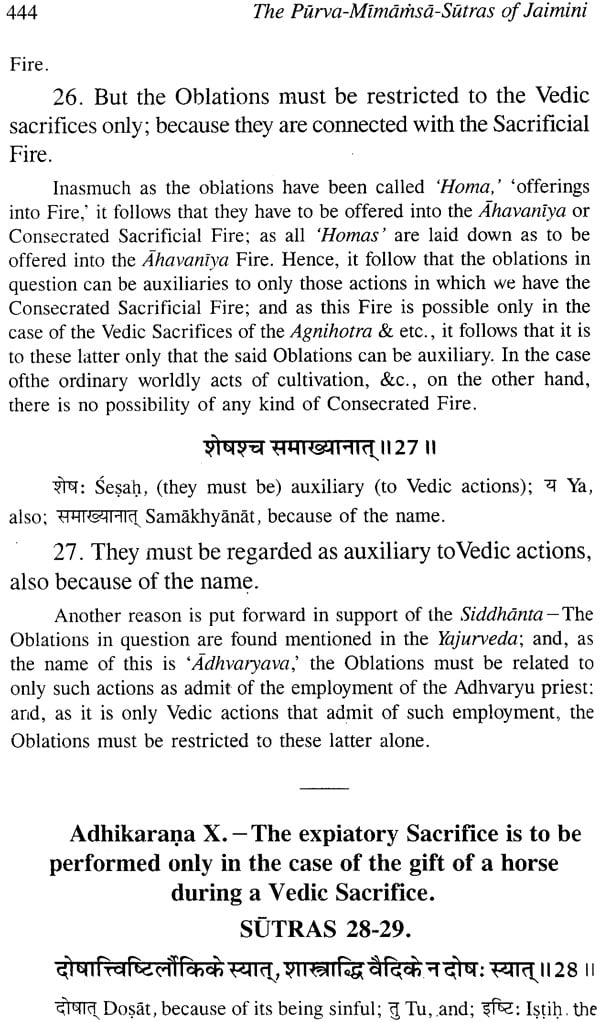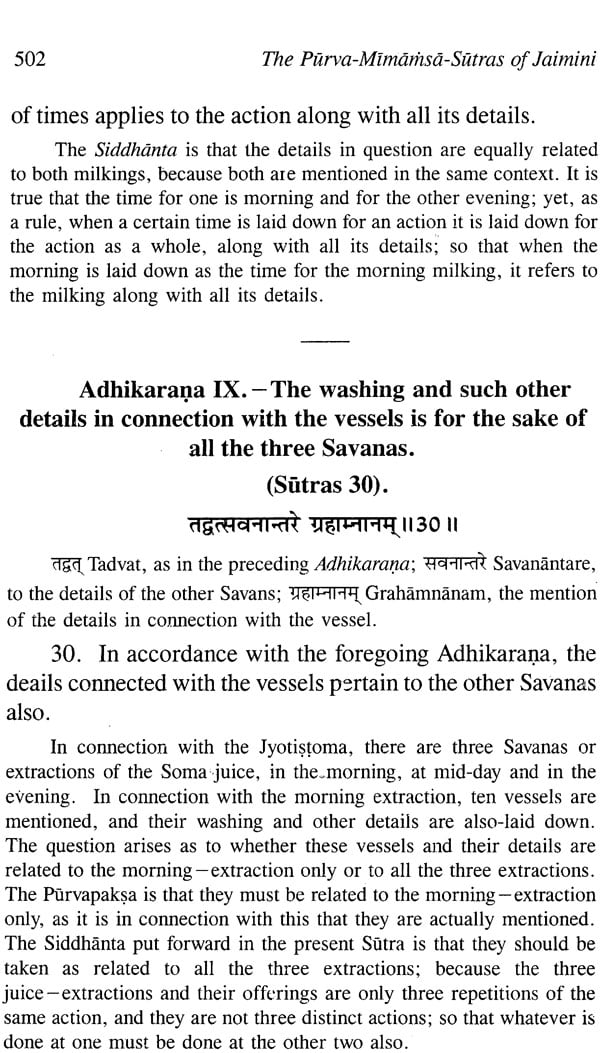
The Purva Mimamsa Sutras of Jaimini
Book Specification
| Item Code: | NAO663 |
| Author: | Pandit Ganganatha Jha |
| Publisher: | Parimal Publication Pvt. Ltd. |
| Language: | English |
| Edition: | 2018 |
| ISBN: | 9788171106288 |
| Pages: | 622 |
| Cover: | Hardcover |
| Other Details | 9.0 inch X 6.5 inch |
| Weight | 880 gm |
Book Description
The Purva Mimamsa Sutras of Jaimin is one of the most important ancient Hindi philosophical texts. It forms the basis o Mimamsa, the earliest of the six orthodox), schools (Dars'anas) of Indian Philosophy The complete work is divided into twelve adhydyces (chapters) which are further divided into sixtypadas (sections). The text provids rules for the interpretation of the Vedas and also provides philosophical justifications for the observance of Vedic rituals, by offering meaning and significance of Vedic rituals to attain Moksha.
Jaimini, in his Mimamsa Sutra, presents material activity and its results as the whole of reality. He and later proponents of Karma-mimamsa philosophy teach that material existence is endless, that there is no liberation. For Mimathsas, the cycle of karma is perpetual, and the best one can aim for is higher birth among the Devas. Therefore, they hold that the whole purpose of the Vedas is to engage human beings in rituals for creating good karma, and consequently the mature soul's prime responsibility is to ascertain the exact meaning of the Vedas' sacrificial injunctions and to execute them.
The present book, in addition to original Sutras, includes English translation and an exhaustive commentary in English by Sir Ganganath Jha of first 3 Adhyayas of Mimcirnsei Sutras of Jaimini. It also contains an alphabetical index of Sutras at the end for the benefit of readers.
From the earliest times, Indian philosophers have laid stress upon Karma, action (principally, sacrificial action) and Aetna, knowledge (principally knowledge of the Self) as essential for men. Among the six well-known "Philosophical systems," which are to be regarded as so many distinct 'disciplines' rather than `philosophies'— we find that though one may incidentally lay greater stress upon 'knowledge' than 'action' they all agree in maintaining that, though the direct cause of Final Release is knowledge alone, and on this point practically all are agreed— the performance of actions also is a necessary preliminary step; even the Vedants, with its thorough going Idealism, admits the usefulness of mental and bodily discipline. Among actions, again, in addition to those that are necessary for the keeping alive of the Body, the most important are those that are enjoined in the Veda. All the six systems are agreed on this point.
At the time that the country was full of Vedic scholars, who also had direct access to the original 'Seers', to whom the Vedas had been 'revealed' it was easily known what actions were enjoined by the Veda. With the advent of worse times, the minute study of the Vedas declined, and fully qualified scholars began to become scarce; so that it became increasingly difficult to ascertain the real import of Vedic injunctions; and it became necessary to have certain rules for guidance in the interpretation of the Vedic statutes. At this juncture, Jaimini came and composed his Sutras, known variously as Turva-Mimamsa- Sutras’, `Mimamsa-Sutras' and Jaimini-Sutras’.
These Sutras are divided into 12 Adhyayas, chapters, which are divided into Tadas'; divided again into `Adhikaratias' or `topics', of which there are nearly 1,000. Each of these topics takes up one doubtful point, and by a series of reasoning, arrives at the right conclusion. For every Adhikarana there is (1) visavavdkya, a Vedic sentence, in regard to which there is (2) saritfaya’, doubt, as to what is its correct meaning; then we have the (3) prima facie view put forward, called the Parvapaksa’, and this is followed by the (4) refutation of this prima facie view, after which comes (5) the Final view or Siddhanta, These constitute the five limbs or factors of every Adhikarana.
Of the twelve Adhyayas, the first deals with the sources of knowledge as to Dharma; the second with what indicates difference among actions; the third lays down principles by which it is ascertained what is sub-servant to, or part of, which act; the fourth deals with the Motive underlying the acts; the fifth with the order of sequence among actions; the sixth with the question as to persons entitled to the performances of the acts; the seventh with the subject of transference of details from one to the other action; and the same subject is dealt with in greater detail by the eighth adhyaya; the ninth describes those cases where certain modifications are introduced into the original action; the tenth treats of cases where the transference of details is not permissible; the eleventh points out instances where a single performance of an act serves the purposes of several sacrifices; and the twelfth with those cases where the details have to be repeated with each of the several sacrifices.
These Sutras have had several commentators - such as Upavarsa Bhartrmitra and others. These, however, are known to us only in name. The earliest commentary known to us is that by Shabara, known as the Thasya’. This has been published in the Bibliotheca Indica, and also at Benares in the Chaukhambha Sanskrit Series. This Bhasya has had two sets of followers— one headed by Prabhakara, who wrote his commentary on the Bhasya, known as the 'Brhate , which has been commented upon by Shalikanatha Midra, in his Tjuvimala'; and the other headed by Kumarila, also called Thatta' who, wrote his commentary on the Bhasya in three parts— Part (1), called the Slokavarttika' , deals only with the 1st pada of Adhyaya I, (2) called the Tantrvarttika proceeds up to the end of Adhyaya III and (3) the Tuptika dealing with Adhyayas IV to XII. This Vartika of Camarilla has had several commentators — Sucarita Midra (author of the Kasika on the kokavartika), Somedvara Bhatta (writer of the Nyayasudha, also known as `Ratjaka’, which is a commentary on the Tantravarttika), and, Parthasarathi Miira (author of the Nyayaratnakara on the Slokavartika, and the Jastradipika, an independent commentary on the Sutras, and also of the Tantraratna, which deals with Adhyayas IV to XII). These have been followed by several other writers. As regards the translation, I am afraid it will be found to be a very unequal work. In the beginning, I adopted a somewhat ambitious plan, making the 'commentary' a really 'original' one. Later on, however, I was obliged to depend entirely upon the Tantravarttika, which I had translated for the Asiatic Society of Bengal. Subsequently the amount of fresh material put at my disposal by my friend, Babu Govinda Das, accumulated to such an extent that I came to the conclusion that a really exhaustive translation of the Sutra and its commentaries will have to be made on the lines of my translation of the Nyaya-Sutras now appearing in Indian Thought. Since coming to this conclusion, I confined myself, in the present work, to a very brief account of each Sutra and Adhikaratia, on the basis of the `Subodhinr. As soon, however, as my hands are free from the Nyaya Sutras, I intend to take up the critical translation of the 85.bara-Bhava along with copious notes from all available commentaries, chiefly Prabhakara's Brhati and Kumarila's Varttika, with their respective commentaries. Thereby I shall, I hope, atone for the discrepancies of my present work.
The work has turned out to be a long one; and for this reason the publishers have wisely decided to issue the first three Adhyayas as Vol. 1.
In this work as in all my works, I am indebted to my friend, Babu Govinda Das, without whose help I could not have obtained even a fraction of the material that he has supplied me with, and without which my work on these Sara would have been impossible.
For the list of contents and the index I am indebted to my sons, Bhavanatha and Amaranth.
| First Adhayaya. Means of Acquiring Right Knowledge of Duty, | , |
| First Pada | |
| The Tarka-Polemical-Pada | 1-22 |
| Second Pada | , |
| The Authority of the Arthavada | 26-50 |
| Third Pada | |
| The Authority of Smrtis and usage of matters relating to Dharma | 63-104 |
| Fourth pada Treating of the Names of Sacrifices | 111-136 |
| Second Adhyaya | |
| First Pada | |
| Different of Actions and Texts prescribing them Introductory | 141-197 |
| Second Pada | 199-249 |
| Third Pada | 257-293 |
| Fourth pada | 295-301 |
| Third Adhyaya, | |
| First Pada, | 319-339 |
| Second Pada, | 341-334 |
| Third Pada | 377-417 |
| Fourth Pada | 425-456 |
| Fifth Pada | 458-485 |
| Sixth Pada | 487-509 |
| Seventh Pada | 513-538 |
| Eighth Pada | 541-563 |
| Alphabetical Index of Sutras | 565-586 |


